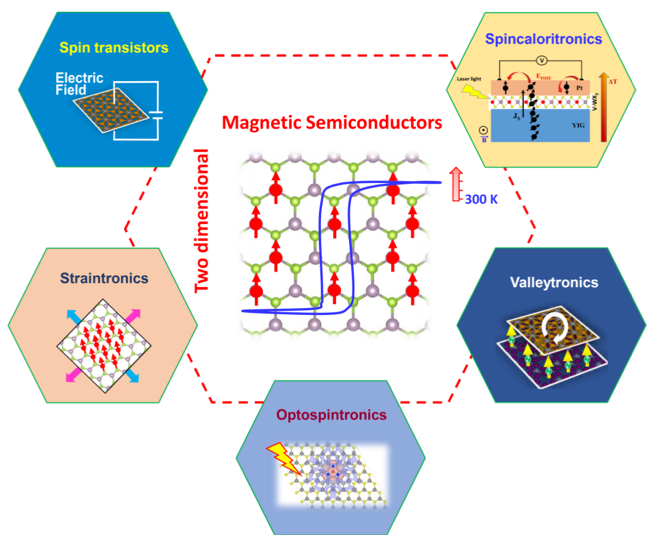Current mobile phones, computers, and electronic appliances operate based on field-effect transistors (FETs) that use an electric field to switch on/off a charge current of electrons in a nonmagnetic semiconductor, encoding information in the 1/0 digital state. In these FETs, however, electrons move physically, slowing down information transmission and consuming much power. Their miniaturization to the nanometer scale (which is one-billionth of a meter) also hampers their performance substantially due to the current leakage, rendering them unusable in ultrafast electronic nanodevices, especially in supercomputers or in future quantum computers.

Tunable room temperature ferromagnetism in two-dimensional V-doped TMD semiconductors enables the development of novel spin transistors, spincaloritronics, valleytronics, opto-spintronics, and straintronics.
These challenging issues have been overcome by the development of spintronics (spin + electronics), which exploits, instead of the charge of electrons, the spin of electrons and its alignment (up or down) in a magnetic semiconductor to encode the 1/0 digital information. Unlike classic electronics, the use of spin directions to store and carry information in spin transistors or spintronic devices enables fast information transmission while requiring minimal power to operate.
Atomically thin magnetic semiconductors are being tapped as the primary components of a new generation of computing devices based on spintronics. In addition to their miniaturization, these two-dimensional (2D) magnets enable faster processing speeds, lower energy consumption, and even increased storage capacity. To fully exploit their impressive potential, these materials should not require cryogenic temperatures or other special protections to function. Therefore, it’s incredibly important to have control over their unique atomic-level magnetism at temperatures close to room temperature, at which most of our devices operate.
Now, research teams from the University of South Florida (USF), led by Professor of Physics Manh-Huong Phan, and Pennsylvania State University (PSU), led by Distinguished Professor of Physics Mauricio Terrones and Distinguished Professor of Physics Vincent H. Crespi, have made the surprising discovery of strong and tunable room-temperature magnetism in the 2D van der Waals magnetic semiconductors V-WS2 and V-WSe2 (also known as transition metal dichalcogenides or TMDs). In their recently published articles in Advanced Materials and Advanced Science, the teams demonstrated an enhanced magnetization and achieved the highest doping level ever attained for atomically thin vanadium-doped transition metal dichalcogenides.
This achievement is crucial as tuning the magnetization of a 2D magnetic material supports emerging quantum computing concepts such as spin logic switches and spin transistors. In addition, the authors discovered a new thermally induced spin flipping (TISF) phenomenon in V-WSe2 monolayers. Interestingly, the TISF phenomenon can be achieved at low magnetic fields (less than 100 mT) and manipulated by modifying the vanadium concentration within the WSe2 monolayers. These findings could open doors for opto-spincaloritronics, valleytronics, and quantum computation.
“Following our previous discoveries of the strong room temperature ferromagnetism in metallic monolayers of VSe2 (reported in Nature Nanotechnology, 2018) and the giant spin Seebeck effect through an interface organic semiconductor (reported in Materials Horizons, 2020), these new discoveries of the tunable ferromagnetism and the thermally induced spin flipping effect at room temperature in the semiconducting V-WS2 and V-WSe2 monolayers could revolutionize quantum information technology, which has positioned our research group at USF’s Department of Physics, in close collaboration with the PSU team, to drive the rapidly expanding research field of two-dimensional magnetism,” said USF lead Manh-Huong Phan.
The additional USF team members working on this project include Yen Thi Hai Pham, Valery Ortiz Jimenez, and Vijaysankar Kalappattil. Work at USF was partially supported by the U.S. Department of Energy, VISCOSTONE USA, and the University of South Florida Nexus Initiative (UNI).
The research teams are presently developing several novel techniques for the design, synthesis, and characterization of new classes of two-dimensional magnets and heterostructures with enhanced functionalities that will fulfill the increasing requirements of modern multifunctional and quantum nanodevices. It is anticipated that enhancing ferromagnetism in these semiconductors not only advances the field of quantum spintronics, but also enables the exploration of new and exciting dimensionality-driven magnetic phenomena.
References:
1 Y.T.H. Pham, M.Z. Liu, V.O. Jimenez, F. Zhang, V. Kalappattil, M. Terrones, and M.H. Phan, Tunable Ferromagnetism and Thermally Induced Spin Flip in Vanadium-doped Tungsten Diselenide Monolayers at Room Temperature, Advanced Materials 2020;32:2003607 (DOI: 10.1002/adma.202003607).
2 F. Zhang, B.Y. Zheng, A. Sebastian, H. Olson, M.Z. Liu, K. Fujisawa, Y.T.H. Pham, V. Ortiz Jimenez, V. Kalappattil, T. Zhang, R., Pendurthi, Y. Lei, A. Laura Elias, Y. Wang, P.E. Hopkins, S. Das, V.H. Crespi, M.H. Phan, and M. Terrones, Monolayer Vanadium-doped Tungsten Disulfide: An Emerging Room-Temperature Diluted Magnetic Semiconductor, Advanced Science 2020; 2001174 (DOI: 10.1002/advs.202001174).
3 M. Bonilla, S. Kolekar, Y.J. Ma, H. Coy Diaz, V. Kalappattil, R. Das, T. Eggers, H.R. Gutierrez, M.H. Phan, and M. Batzill, Strong Room Temperature Ferromagnetism in VSe2 Monolayers on van der Waals substrates, Nature Nanotechnology 2018; 13:289.
4 V. Kalappattil, R. Geng, R. Das, H. Luong, M. Pham, T. Nguyen, A. Popescu, L. M. Woods H. Srikanth, and M.H. Phan, Giant Spin Seebeck effect through an Interface Organic Semiconductor, Materials Horizons 2020; 7:1413.
